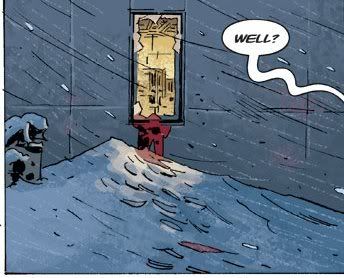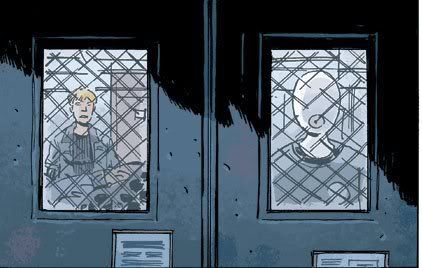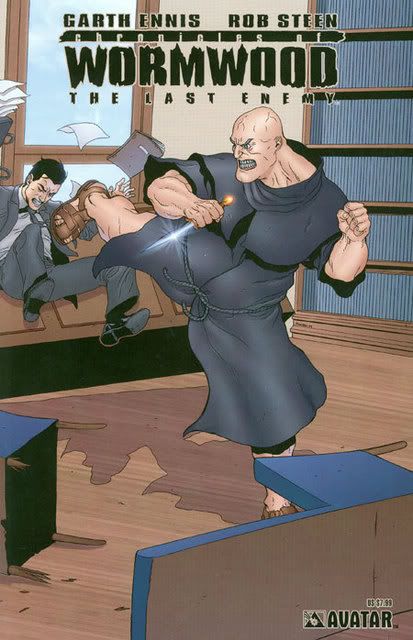The Demon Hero as a Wounded Animal Surrounded by Fire: Jog on 12/12
/![]()

B.P.R.D.: Killing Ground #5 (of 5): Or, "NUMBER 38 IN A SERIES" as the inside front cover says. All of the Hellboy family books bear this sort of double branding, since their tight continuities often have them behaving like ongoing series just as much as the individual miniseries they're titled as. Of course, that's also how storylines in most actual ongoing series work these days, but I think the approach of the Hellboy books has the added benefit of obvious break points that not only allow for the creative teams to pause, but seem to invite the occasional gap of several months, all without upsetting reader expectations.
This particular storyline, however, has been maybe the first of B.P.R.D. to tip the scale more toward 'ongoing' than 'miniseries.' It's really less a beginning-middle-end thing than a thematically-linked bundle of long-simmering plot advancements, arranged so as to suggest a mystery; the larger story inches forward, callbacks are made to several earlier issues, and this final issue doesn't particularly resolve anything, although it does come complete with an extensive backstory infodump, and a last page cliffhanger. A fairly lyrical one that neatly (and visually!) summarizes the concerns at play, mind you.
The topic has been monsters, paranoia, and the violent capacity of the self. Most of the cast came face to face with some violent inner struggle, from Abe's encounter with a once-human Wendigo from his past, Liz's struggles with the apocalyptic burden she carries, and, most crucially, Daimio's absorption into the sinister facets of his origins. There was also a counterpoint in Johann's experience with a lovely new human body, with the thoughtful wraith instantly becoming wild for simple physical sensation, to the detriment of his ghostly duties.

Woe betide those who mistake the eventual collected edition for a good jumping-on point - reading through this issue, I found myself hastily flipping around earlier stories just to get my bearings, even though all this 'conclusion' really does is try to explain some things, while the larger plot inches forward and most of the characters sorta change. Nearly everything of note that occurs will hold less impact if you're not very familiar with earlier issues in the series. Or even issues of other series - a seemingly opaque Lobster Johnson cameo in issue #4 may well tie in with the concurrently-running Lobster Johnson: The Iron Prometheus; as it was with Alan Moore's now-departed ABC line, Mike Mignola's comic book universe rewards completists.
Still, even if this issue reads like little more than a waypoint between bigger landmarks, it is a work of fine construction. There's little that needs to be said of the visceral impact of Guy Davis' drawings and Dave Stewart's colors, but it's always worth pointing out how well they cooperate with Mignola's and John Arcudi's scripts - in an issue so thick with people telling other people important things, it's great to have that long flashback interspersed with images of Johann's ectoplasmic form fading from his recent he-man persona into the mild fellow he was before, Davis' lines sketching in his dignity with a job well done. Even if we're left on a question mark while a new team presents a '40s side-story for the next few months, the details linger in a GOOD way.
Chronicles of Wormwood: The Last Enemy: Meanwhile, Garth Ennis and Avatar present a funnybook embodiment of 'unnecessary.' I liked the initial Wormwood miniseries ok enough - it was an amusing, idiosyncratic piece of humanism, using biblical figures to promote personal responsibility above reliance on established power structures... and what could be more established than God and Satan and all that? Cute, and complete.

Yet here's a $7.99, 48-page one-shot sequel, feeling awfully overextended. The plot concerns errant Antichrist Wormwood's attempts to woo back his ex-girlfriend, while the debauched Pope Jacko sends a hulking killer eunuch to retrieve Wormwood's pal Jesus Christ for the purposes of curing his AIDS. Along the way there's jokes about jerking off, icky bodily mutiliations, priests (were you aware that they like to fuck young boys?!?!), a rabbit doing human things, and that one time a guy jumped off the Empire State Building and splattered on a ledge and his severed leg landed outside of Jim Hanley's Universe. We also discover that it's nice to be a nice person!
"So basically you're saying you're a pussy now, is that it?"
"That's exactly it, Jimmy. That's the moral of the story right there."
The problem is, it's really nothing that hadn't been done already in the original series, with more panache. Now, Ennis is a canny writer, and can drag a small bit of interest out of almost anything - even a lame, space-eating recurring segment about Wormwood helping to record a dvd audio commentary for one of his television programs boasts the small pleasure of the show itself gently commenting on Wormwood's mental state. But even then, production issues betray the book; if you're going to base a multi-page routine around characters talking from off-panel, and you're not going to differentiate their word balloons by shape or color or something, it would help to have each character's dialogue come from their own distinct off-panel area. Or, barring that, at least consistent sides of the panels.
The art doesn't lift it up much. Rob Steen, illustrator of the Ricky Gervais book Flanimals, takes over for original artist Jacen Burrows (who does draw the cover, as seen above), and he does provide a few funny reactions. Plus, he and (especially) colorist Andrew Dalhouse do an impressive job of making things look sort of consistent with the original; I've always felt Avatar's use of a small, distinct group of colorists has gone farther than anything else in forging a visual identity for the publisher. But there's still some awkwardness to physical interactions -- of particular note is a lesbian kiss in which one party appears to be suckling on the other's chin -- and a general lack of dynamism that leaves the various action pages feeling detached from the mayhem Ennis is serving.
And even after all that, be aware that the story itself still doesn't quite make it the whole 48 pages, so there's also pair of two-page, religion-themed backups drawn by John McCrea and Russ Braun. Although both of actually manage to be a little funnier by virtue of not being so stretched out. Still, AWFUL on the whole.











